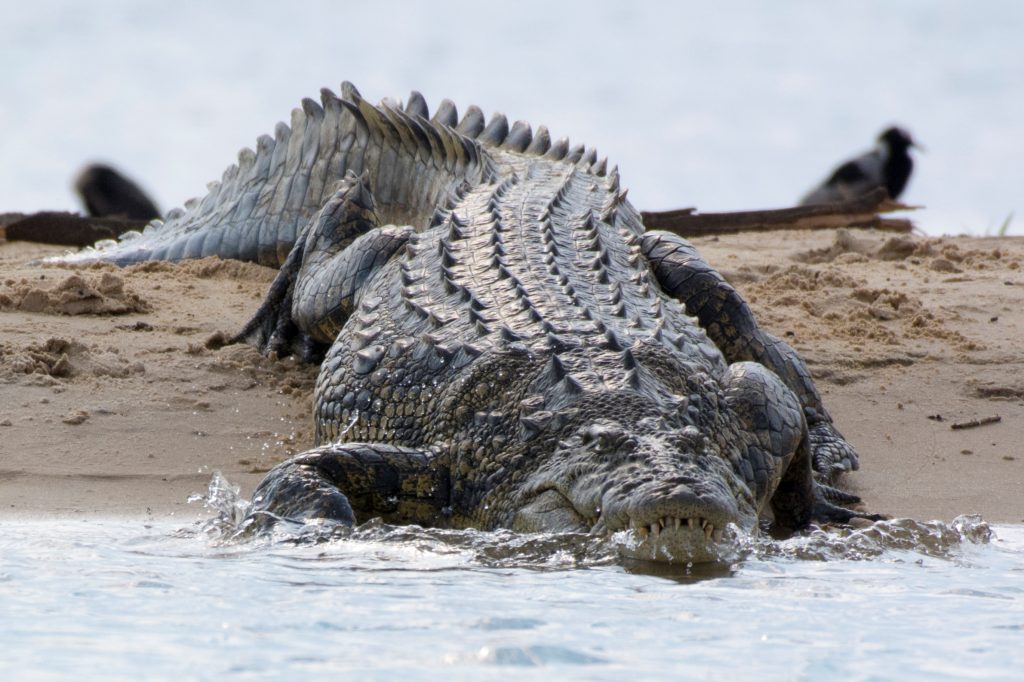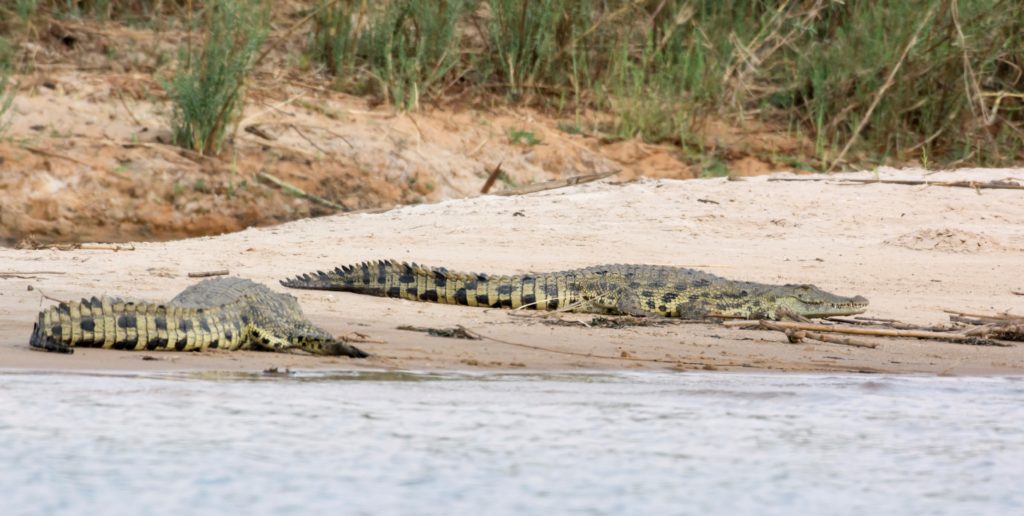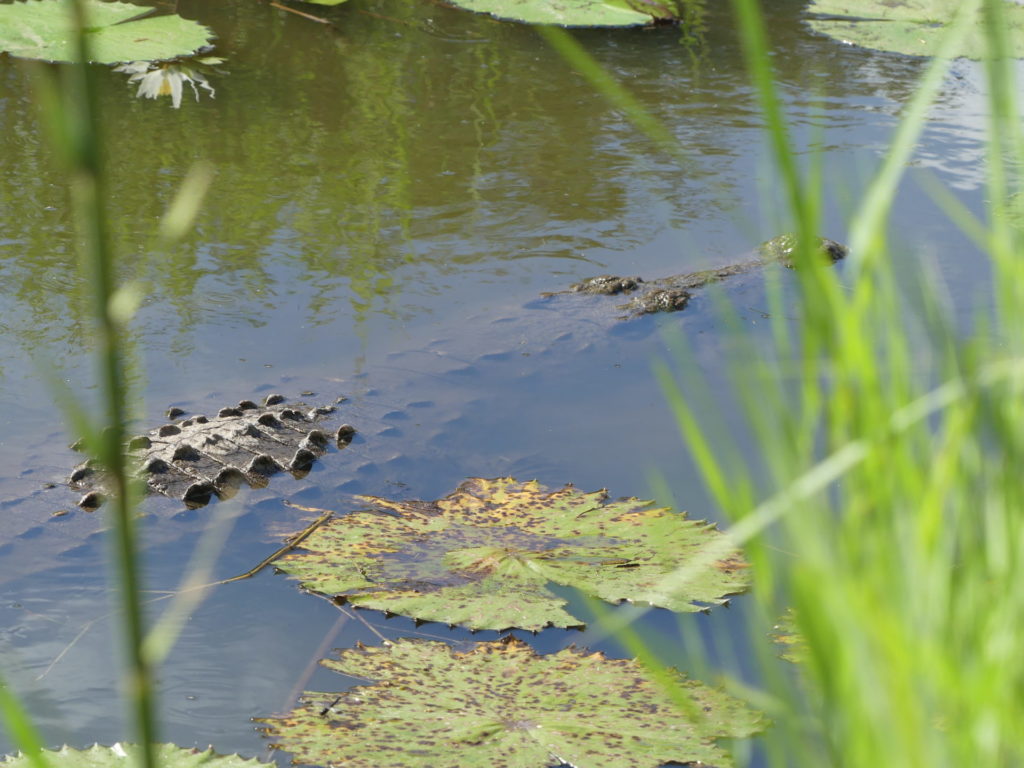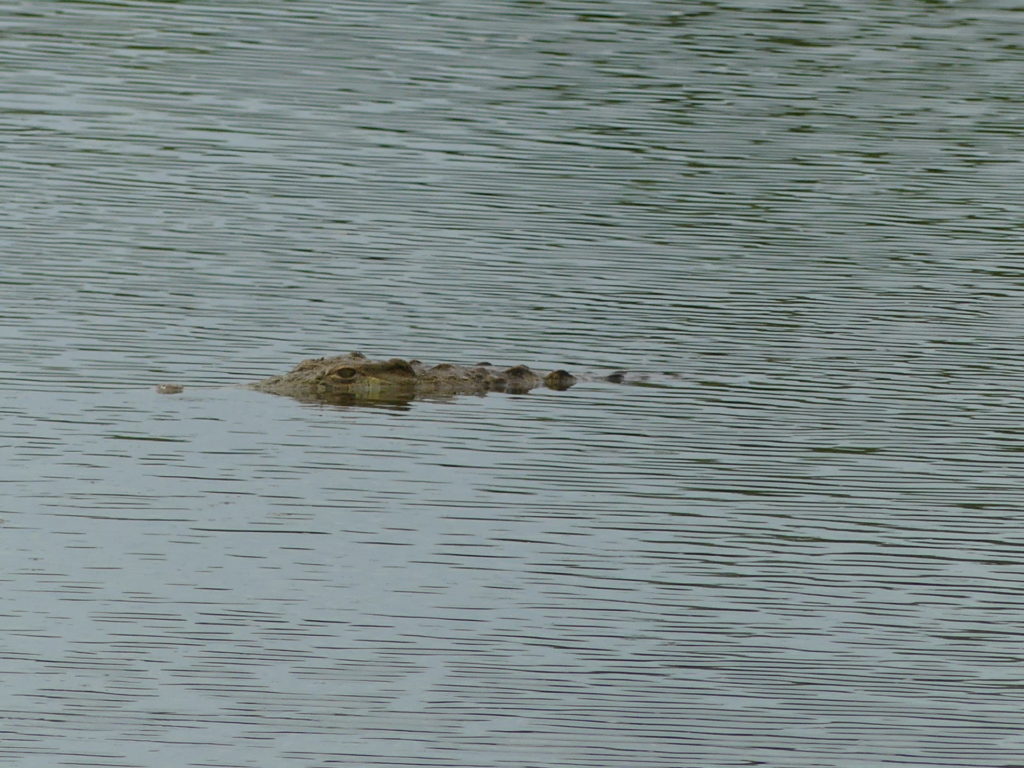Nile crocodiles (Crocodylus niloticus) are colloquially called just crocodiles or ‘crocs’ in the following. They occur in Southern- and Eastern African regions and along the Atlantic coastline in Central Africa. They eat any animal they can get a hold of and are dangerous to humans from a total length of about 2,5 m onwards.
How to spot crocodiles
These crocodiles are living in every bigger lake and perennial river outside of semi-desert areas. On careful observation, either the crocodiles’ heads or backs can be seen in the water, or they basking on a sandbank or finding their tracks and scats on the banks. When they are sunbathing outside the water and getting disturbed by humans, their immediate reaction will be to get back into the water. They learned over many thousands of years, that humans can throw things from a distance, which hurts.

Nile crocodile tracks on river banks can nearly not be confused with water monitor tracks, as the lateral distance between the left and right feet is large, and very often, flat areas created by the moving belly can be seen. And crocodile scat looks at first sight very similar to hyena scat. It is the same bright white color, size, and shape, but when breaking apart, crocodile scat has no pieces of bones or hair inside but is dense and fine-grained like mortar.


Danger of Nile crocodiles
If they are in the water, they are highly dangerous. Swimming in African wild waters is strongly discouraged, as both crocodiles and Bilharzia (caused by parasitic flatworms) are on the prowl for a meal. Over 90% of crocodile attacks occur either in or near the water.
Therefore, not only swimming but also wading, fishing, gathering water, cleaning fish at the water’s edge, and all such kinds of activities are highly dangerous. If using a boat on the water, it should be remembered, that the smaller the vessel, the higher the danger is; as there are many recordings, where crocodiles were lounging out of the water and onto the vessel and grabbed the person.


Suggested behavior of anglers for not getting attacked by crocs
When angling, it is strongly advised to change the location on the water’s edge every 5 seconds. Nile crocodiles try to position themselves perpendicular to the water’s edge directly in line with the victim, so that they can shoot out of the water in a straight line. When changing the location very frequently, they will not have the time to take the correct attack position.
The most dangerous time in and on the water or near the water’s edge is dusk, dawn, and nighttime when they are most active. Once in the morning dusk, we saw a crocodile attacking a cow who was coming to drink on the Zambezi River, trying to pull her into the river. Loud mooing alerted the herders, who managed to get her free from the croc with sticks they were punching into the croc’s head.
Finding crocs during nighttime
When dark, it is easy to see their eyes with a flashlight. That’s also the way for humans to catch small Nile crocodiles. Blind them with a flashlight in one hand and catch them with the other hand from behind. But it is very surprising for persons who handle them first time, how strong such only 50 cm long crocs are. Both hands are needed to hold such a baby croc securely in place.
Danger of breeding female crocs
A special danger from crocodiles is in the wet season in Southern Africa, as nesting begins from the first rains onwards (November) and the eggs are incubated for up to 3 months. During that time the female will protect the nest fiercely. So, from the rains in November to the end of the Marula time, there is a heightened risk of being attacked by female crocodiles, when walking in reed beds or densely vegetated areas along water bodies.
Sleeping outdoors near crocodile-infested waters
When sleeping outdoors near crocodile-infested waters, the standard recommendation is to be at least 2 m above the high-water mark and 50 meters away from the water’s edge. As I do not always know what ‘2 meters above the high-water mark’ is, as pans, lakes, and rivers very often have shallow edges without any marks, my recommendation is to stay at least 150 meters away from the water at a well-protected place and out of sight from the water.
Nile crocodiles are not to be underestimated. They will figure out when some slow-moving animals (humans) are staying at a place near the water for a longer time and will check it out during nighttime. In case of meeting a croc on land close by, the best is to run in a straight line away from water. On land, crocs can run up to a speed of 17 km/h, which can be surpassed by humans for a short time. In water, however, the swimming speed can be up to 60 km/h for mature crocodiles.
What to do when bitten by a Nile crocodile?
If unfortunate and the croc will bite, it could be a defensive bite, which is one, when after biting it lets go. But if the croc continues holding on, it will either try to pull the victim into the water or when already in the water will turn around its length axis in multiple spins to drown the victim.
Whatever it is, the most important is to fight back. Very close to the teeth are their highly vulnerable eyes, and it has to be tried to poke fingers or the thumb into the eyes. If not possible, the head should be attacked by as many blows as possible. If this is not good enough, the palatal valve in behind the tongue should be opened by hand. It consists of soft tissue, which prevents water from flowing into its body when diving underwater, and when opened, will force the croc to release the victim, in order not to drown itself.
When getting bitten, it is important to get professional medical attention as fast as possible, as a high bacteria load in the Croc’s mouth area will cause severe wound infections.
Lessons learned about the danger of crocodiles
- When on the edge of croc-infested water bodies, change location very frequently
- Never camp closer than 150 meters from waters containing large crocs
- On land, you can outrun a Croc
- When bitten and the croc hangs on, poke fingers in its eyes or try to open its palatal valve in its throat.



